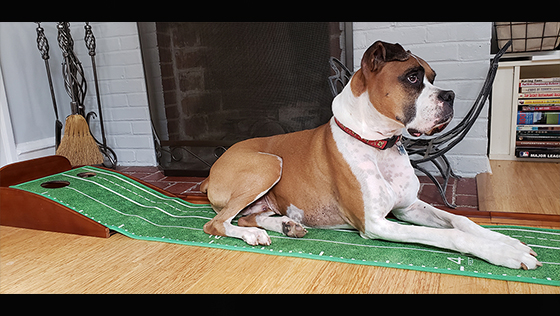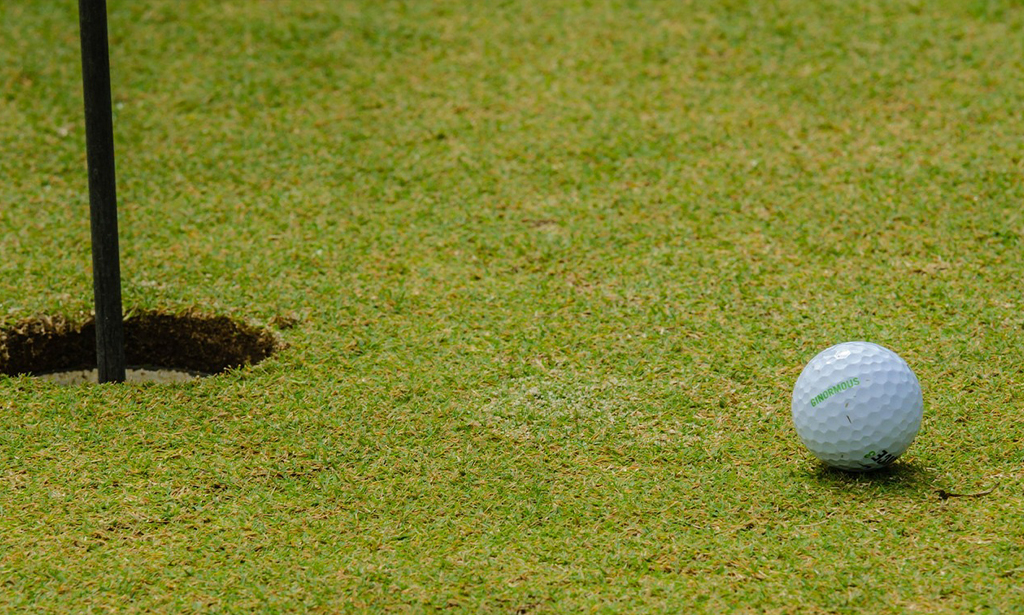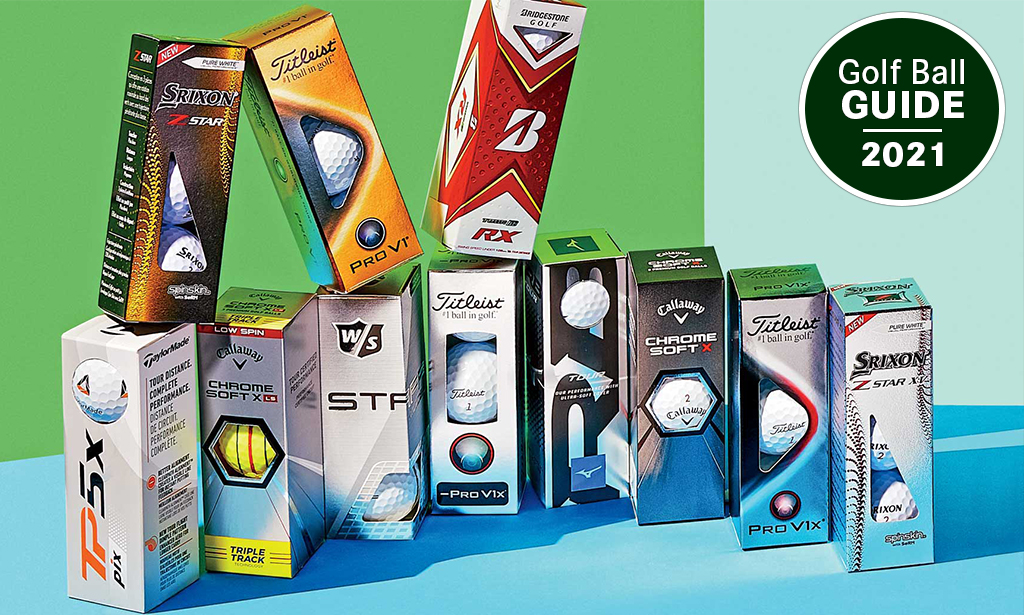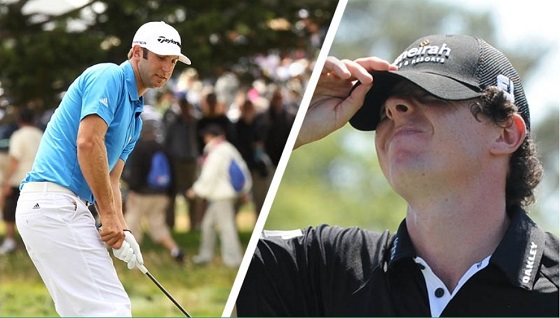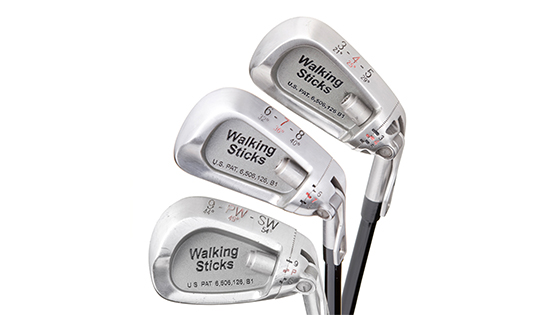News
Crazy Story Behind Spieth’s Iconic Putter

Preconceived notions and biases are built into a golfer’s DNA, whether that be brand loyalty from a commercial we see while watching the Ryder Cup or the simple nostalgia we feel from pulling out Dads old set of hand-me-down clubs.
All of that is supposed to be thrown out the window, however, when one goes in for a club fitting. After all, let’s be honest, the reason a golfer gets fit in the first place is to find the best possible club to fit their game; not backing into the math and jerry-rigging your game to fit a piece of equipment.
That’s easier said than done, of course, and not simply reserved for the average weekend golfer, as a recent Jordan Spieth interview revealed.
When you think of the three-time major champion and his equipment, there’s only one club that seems synonymous with Spieth: Every golfer knows that the oTexas kid is deadly with the flat stick! His Scotty Cameron 009 putter with a Triple Black finish is almost as iconic as Tigers Newport 2 Studio Stainless with the Red dot! Hold on, hold on…before you go crazy… I said almost (LOL)!

Appearing on Inside The Circle T, a YouTube series in which Cameron loyalists talk about their putters, Spieth told Scotty Cameron Tour rep Drew Page that even he did a little manipulation in order to find the putter he wanted. Now, Spieth wasn’t your typical junior golfer going in for a local putter fitting at Dicks Sporting Goods. He was one of the top juniors in the country, and as such, Spieth was invited to go into the Scotty Cameron Putting Studio in California to get fit like a Tour pro. On multiple occasions, he brought his own biases into the fitting: When all was said and done, he overcame those and walked out with a Scotty Cameron Teryllium 1.5 putter that fit his stroke.
“I really wanted to go in and get a GSS, because my friends at the club I grew up at were like, ‘Dude, this is like a $5-10,000 putter; this is German Stainless Steel, it’s soft, it’s what Tiger uses, it’s what all the pros were using,” Spieth said of his first visit.
“I wanted to be open to maybe what would be the best for me, but in the back of my mind, we didn’t try a GSS for like the first 3 or 4 putters that I was hitting there, and I was like, ‘Hey, do you care if I try one of those? I just kind of want to see the feel.’”
Spieth, set those desires aside, and walked out of that first fitting with a Scotty Cameron Teryllium 1.5 putter, which he used to great success for the next four years or so. As he was wrapping up his high school career, Spieth headed back to the Putter Studio, this time with even stronger biases despite having a fantastic putter already in his bag. Bottom line, he wanted something else. He knew what it was and so did Scotty!
“Adam Scott had a 009, Geoff Ogilvy was putting with a 009, those were like my favorite players,” Spieth said. “I really wanted a Triple Black 009. I was putting great with my putter in the studio, but I tried out (the 009) and was like, ‘This is just a different look. This would be a good idea if I kind of wanted to look at something different.’
“I remember just trying to justify it, doing anything I could to walk out with a different putter than I walked in with.”
It wasn’t just Spieth justifying a desire for a new look, he went so far as to miss putts on purpose with his Teryllium and make them with the 009 he had set his sights on. Spieth sandbagged his fitting to get what he wanted!
“Yeah, it was like, ‘This one (the Teryllium) is rotating too much, maybe if I try this one over here (the 009), it would be better.’ I would manipulate the stroke a little bit.”
Spieth did eventually walk out with the 009 he wanted, and even though he admittedly felt he was putting better in the immediate aftermath with the Teryllium, he switched to the 009 that he’s still using today.
“It’s not Triple Black anymore, it’s almost like chrome on the bottom now, and it’s pretty damn rusty,” Spieth said. “It’s got its nicks, but whenever I switch to something else for a day and I look back at my putter, it just has that look to it that’s just been great for me.”
Twelve PGA Tour wins, three majors, and nearly $48 million in on-course earnings later, maybe those preconceived notions aren’t the worst thing to come into a fitting with… so long as you’re Jordan Spieth.

Check back often to stay informed on everything happening on and off the course.
- Why this guide to perfect ball position was our most-read tip of 2025
- What TGL’s new hole designs reveal about golf and travel
- How much is Tiger Woods actually worth to golf? We investigated
- The wedges used by the top PGA Tour pros in SG: Around-the-Green in 2025
- The 12 most memorable wins of 2025
- I Tried It: Why these sunglasses were the best thing I used in 2025
- Rules Guy: How does a Local Rule become a universal rule?
- 8 most heated moments from the 2025 pro golf season
- Inside the launch of TGL, one of the golf stories of the year
- I Tried It: Why this rain jacket was my favorite golf product of 2025
- What does Rory McIlroy have after dream season? 1 big ambition
- These 13 players just earned Masters invites for 2026
- From the top iron players on the PGA Tour, 1 trend emerges
- Tommy Fleetwood broke through in 2025. But his defeats told the story
- Lee Trevino’s epic speech and a tearful finish: 12 PNC (and golf) questions!
News
The 6 Most Ridiculous Rules in Golf

Let’s get these changed ASAP huh Fellas?
Remember Dustin Johnson pleading to a rules official during the final round of the 2016 U.S. Open. I had his back and most of the world did too.
They say you can’t fix stupid, but you are able to complain about it and hopefully get it changed. Golf, this game we love, there is plenty of senselessness to go around. Witness the Rules of Golf, an encyclopedic catalog of do’s and don’ts that often fall beyond the bounds of reality
For argument’s sake, here’s our take on six of the dumbest rules in the most beloved sport on the planet. OK, maybe I am biased, but the game is pretty old and may need a little botox here and there. Just Sayin’
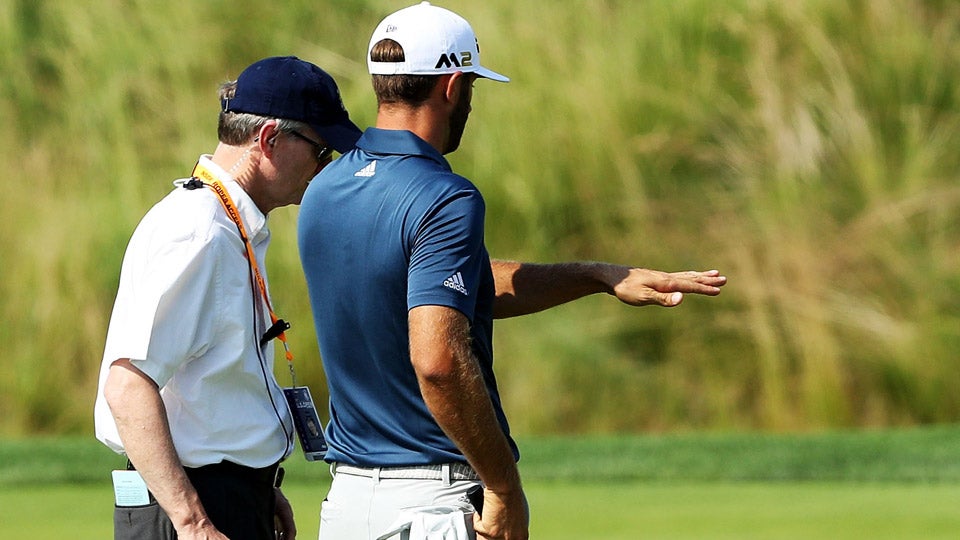
1. The Dreaded “DJ Rule
In the official ledger, it’s Rule 18-2. But ever since the 2016 U.S. Open, it’s more widely recognized as that *&%$!!!-ing Dustin Johnson Rule. You know, that nonsensical one under which the eventual tournament winner was slapped with a one-shot penalty for supposedly causing his ball to move a nano-millimeter on the 5th green. Never mind that he clearly didn’t intend to set the ball in motion, or that the micro-movement gave him no discernible advantage. The punishment stood. But we shouldn’t have to stand for it in the future. How about this? Next time around, no harm, no foul. Move the ball back, end of story!

2. No Relief from Sand-Filled Divots – In the fairway?
Let’s see if we understand correctly: if we spray a tee shot off-line and our ball winds up in the ground under repair zone, we’re entitled to relief. But if we smoke one down the middle and it settles in a sand-filled crater left behind by another golfer, we’re doomed to play it as it lies. That ground we landed in happened to be damaged. Someone tried to repair it. Sounds to us like… the ground is under repair. Now Im no genius, but are you following me here?
2. The “DROP”
You’d think that hitting a shot into a hazard would be punishment enough. But you’d be wrong. Under the Rules of Golf, the dogged victim then has to go through the tedious ritual known as the drop, which brings other potential rules infractions into play. If the dropped ball moves closer to the hole (as it so often does) twice, the player gets to place it. So why not just allow placement from the start? It would spare the player undue pain, and save the rest of us a lot of time.
3. Stroke & Distance
In American jurisprudence, it’s known as double jeopardy, a procedural defense that protects us from being prosecuted twice for the same crime. Sounds reasonable, right? No such safeguard exists for a golfer who bangs a ball into oblivion, only to be slapped with a stroke penalty on top of loss of distance. That’s two punishments for one misdeed, and it’s unjust by any measure. We, the people, call for a one-stroke penalty and lateral relief. Motion Carries!
4. Sprinkler Head in Your Putting Line
Your approach shot lands pin high, just on the collar, and a straightforward putt awaits, with just one problem: a sprinkler head lies in your putting line. Common sense suggests that you should get relief, no closer to the hole; a sprinkler head, after all, is a man-made impediment. But common sense apparently has no place here. Your only hope is that the course you’re playing has a local rule that allows line-of-play relief from immovable obstructions within two club lengths of the green, which, let’s be reasonable here, should really be the rule that governs all play.
5. Five Minutes for a Lost Ball – Really?
That lax allowance dates back to a bygone era, when life moved at a pastoral pace and golfers had the luxury of lollygagging. This is the modern age. Chop, chop, time’s a-wasting. We’ve got cat videos to watch and vapid tweets to send. The game needs to adapt. And besides, if you can’t find that errant ball in two minutes, you probably don’t want to in the first place. It will be under a rock or in a bush but with just enough clearance that those 9 deadly words are uttered “I think I can get a club on it”
6. Cant move a ball from a footprint in a bunker – This one Grinds my Gears
It might make sense on Tour, where players all have caddies and the grounds are as well-groomed as the gardens of Versailles. But many of the courses we mortals play are under-tended and trod upon by etiquette-flouting chops who don’t even attempt to rake up their mess, creating hazards within hazards. The more sensible alternative: if your ball lands in a footprint in a bunker, move it and place it elsewhere in the sand. Done, End of rant. You may go about your business.
Blog
When Golf Meets Supercars: The World Series of Golf Takes Over Skip Barber’s Mexico Resort
World Series of Golf partners with Skip Barber Racing for a two-year luxury sports series at Gran Reserva, Mexico – where championship golf meets supercars starting April 2026.

Picture this. You’re standing on the 18th green at Gran Reserva, Mexico, finishing a round of championship golf with the World Series of Golf’s signature betting format still buzzing in your veins. The sun’s dropping low. Your heart’s still racing from that final putt.
And tomorrow? You’re driving a McLaren on Skip Barber’s brand-new racetrack.
Two Sports, One Unforgettable Weekend
The World Series of Golf just announced something we’ve never seen before. A two-year partnership with Skip Barber Racing School that transforms their new Mexican resort into the ultimate luxury sports destination. It’s not just golf. It’s not just racing. It’s both, wrapped into an experience that redefines what a sporting weekend can be.
Starting in April 2026, Gran Reserva becomes ground zero for a completely new kind of event.
Year One: The Foundation
The first year lays the groundwork. You’ll compete in the World Series of Golf championship using their patented tournament format – the one that adds poker-style betting mechanics to traditional stroke play and turns every hole into a strategic showdown. High stakes. Real tension. Golf the way it was meant to be played.
But here’s where it gets interesting. While you’re playing, Skip Barber’s building their racetrack right there on the property. You’ll see construction crews working on what will become one of North America’s most anticipated racing circuits. State-of-the-art simulators give you a taste of what’s coming, letting you experience the thrill of motorsports between rounds.
VIP receptions. Celebrity appearances. Curated culinary showcases that match the caliber of the competition. It’s an invitation-only event designed for people who expect excellence and aren’t willing to settle for anything less.
Year Two: The Payoff
Then 2027 hits. The track is finished. And suddenly you’re not just imagining what it’s like to drive a supercar at speed – you’re actually doing it.
McLaren. Ferrari. Mercedes. Lamborghini. Take your pick and put it through its paces on a circuit designed by people who’ve spent over 50 years teaching professional racers how to extract every ounce of performance from a machine. Skip Barber doesn’t mess around when it comes to motorsports education, and this track reflects that pedigree.

You’ll stay in exclusive luxury accommodations at Gran Reserva, network with athletes and industry leaders, and experience both golf and racing at the highest possible level. All in one place. All in one unforgettable weekend.
Why This Matters
Michael Berg, CFO of Skip Barber Racing School, called it perfectly: “Guests will see the racetrack under construction during our first event and then drive world-class vehicles on it the following year.”
That’s the hook. You’re not just attending an event. You’re watching it evolve. You’re part of the story from day one, and by year two, you’re living the payoff.
Robert Davidman, CEO of the World Series of Golf, added this: “This partnership unites golf and motorsports in an elevated format that caters to international fans seeking competition, luxury, and adventure.”
Competition. Luxury. Adventure. Three words that sum up what makes this special.
Why Sponsors Are Paying Attention
Here’s what makes this different from every other golf tournament trying to get your marketing dollars.
The World Series of Golf’s patent-protected format keeps spectators glued to every shot. Shot-by-shot wagering. Antes that double every three holes. Strategic decisions that matter as much as swing mechanics. It’s golf designed for television, and television designed to keep people watching.
Add Skip Barber Racing to the mix and you’ve got something networks actually want to cover. Over 40 hours of TV coverage. More than 15 million media impressions. Five million-plus social media reach. This isn’t a local tournament hoping for some local news pickup. This is a broadcast-ready event with an audience that’s already paying attention.
The demographics tell the rest of the story. You’re reaching affluent golf enthusiasts who also appreciate high-performance automobiles. International travelers who think nothing of flying to Mexico for a weekend of luxury sports. Decision-makers and industry leaders who network at VIP receptions and actually have the authority to sign deals on the spot.
Title sponsorship gets you naming rights, eight playing positions, and premium TV exposure throughout the broadcast. But even smaller packages deliver value. Hole sponsors get exclusive on-course branding and social media mentions for ten grand. Golf cart wraps guarantee TV and photo exposure because every shot of the tournament includes your brand.
The opportunities are limited by design. Only 18 hole sponsors. Three presenting sponsors. One title sponsor. Once they’re gone, they’re gone.
Want the details? Check out the full sponsorship packages at wsg.golf/sponsorship.
The Bottom Line
This isn’t your typical golf tournament. It’s not your standard track day either. It’s something entirely new – a two-year luxury sports series that gives you the best of both worlds and raises the bar for what a sporting experience can deliver.
Year one plants the seed. Year two delivers the harvest. And whether you’re attending as a player or partnering as a sponsor, you’ll be there for both.
For player inquiries, contact events@skipbarber.com. For sponsorship opportunities, reach out to sponsorship@wsg.golf. These events are strictly invitation-only, and opportunities won’t last long.
Golf and supercars. Mexico and motorsports. The World Series of Golf and Skip Barber Racing School.
This is going to be something special.
-

 Product Review6 years ago
Product Review6 years agoThe Perfect Practice Putting Mat Review by Jason Tenzer
-

 Blog4 years ago
Blog4 years agoLoophole Rule Offers PGA Tour Pros a Mulligan
-

 Blog4 years ago
Blog4 years ago2021 Buyer’s Guide: The Top 10 Value Golf Balls For Distance & Feel
-

 Blog5 years ago
Blog5 years agoGolf Marriage Counselor
-

 Blog6 years ago
Blog6 years ago9 Biggest Chokes Of The Past Decade
-

 Product Review6 years ago
Product Review6 years agoTHE ADJUSTABLE IRONS: WALKING STICKS GOLF CLUBS
-

 Blog4 years ago
Blog4 years agoWhat Your Golf Clubs Say About You
-

 Equipment6 years ago
Equipment6 years agoOHK Sports Interview by Jason Tenzer







